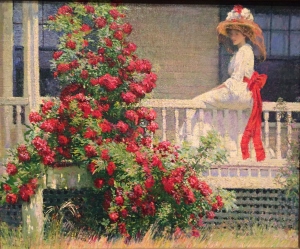Having spent an inordinate amount of time in my own garden recently, I found myself interested in the low-maintenance variety. The Florence Griswold Museum is featuring a joint exhibit with the Pennsylvania Academy of Fine Arts of American Impressionist paintings of gardens.
Here are a few works that caught my eye.
As you know, the Impressionists were all about light and color and thick paint application and that sensation of being in the moment captured in paint. For me, this lovely Harry Hoffman painting really works in all ways.

Harry L. Hoffman, Childe Hassam’s Studio, 1909, Florence Griswold Museum
The flickering light in the blossoms is accomplished through paint application which you can see here.

I could linger for hours in this place. The cool respite of the porch. That springtime moment when the fruit trees have burst open. I love the fresh newness juxtaposed against the comfortably dilapidated. The real dreaminess of the place.
Charles Curran’s A Breezy Day is visceral, too. Can’t you feel that gusting against your cheek and tousling your hair?

Charles Curran, A Breezy Day, 1887, PAFA
We don’t see the hard work of the laundry women, the backbreaking toil of scrubbing, wringing, and ironing. For a moment, we join them outside in the fresh air as the sun peeks through the clouds to bleach the sheets a clean white.
Most Impressionist painters, men and women, conflate their depictions of women with flowers–those ornamental things to be enjoyed for their beauty before it fades. We observe freely, consume for pleasure, reducing women to objects. What better way to understand the stifling moment that also spurred women to agitate for suffrage.
There are plenty such paintings in the exhibit. The one that caught my eye was by a woman artist.
June was created for the cover of a 1902 issue of Everybody’s Magazine, a monthly women’s publication. Even women artists producing images for women perpetuated the woman-as-beautiful-object trope. Violet Oakley may have enjoyed her women the same way as any man, if you catch my drift. Still, as usual, with Oakley, I’m seduced by her vision…

Violet Oakley, June, c1902, PAFA
…and the charming detail of cutting the frame to catch the full sweep of a skirt.

By the way, the red rose in Oakley’s signature references the group of women artists she lived and painted with – the Red Rose Girls.
As ever, I find Lillian Westcott Hale’s work refreshingly feminist. Yes, we have the girl with the flowers–our now familiar symbol. But the flowers are drooping, and the girl seems to be deep in thought, suggesting her worth lies with her mind, regardless of outward appearance. Her ideas bloom, even if her transient bouquet does not. Thank you, Hale.

Lilian Westcott Hale, Black Eyed Susans, before 1922, charcoal and colored pencil on paper, Private Collection

But we really don’t have to be analytical or political. It’s summer. We can simply relish the beauty of our gardens right now.
So join me in getting up close and personal with a rose and looking at its glories through paint.












































